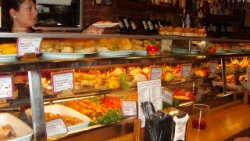
Looks like counterfeit goods are not just the exclusive domain of handbags, sunglasses and accessories here in Spain. According to a study conducted, approximately 30% of Iberian pork products which are labelled are not certified as genuine. New legislation, which is expected to come into force later this month will make it a punishable offence.
Jamon Iberico, sometimes referred to as "pata negra" is the Rolls-Royce of hams. The pigs are fed on a diet of predominantly acorns and are basically "free range", being allowed to roam freely in oak groves. Jamon Iberico can only be made from Iberian pigs, the breeding of which is restricted to an area of Southwestern Spain and Southeastern Portugal. The curing process takes at least 12 months although some producers cure their jamones for up to 48 months.
 |
| Happy Iberian pigs..... |
The hams are labelled according to the pigs diet, with an acorn diet being the best. The finest ham is called "jamon iberico de bollota" - this ham is from totally free range pigs and eat only acorns a minimum of 2 months prior to slaughter. The exercise and diet have a significant impact on the flavour and this ham which is cured for 36 months. The next grade is called "jamon iberico de recebo" - these pigs are fed on a mixed diet of acorns and grain. The third type is called "jamon iberico de cebo" or just plain "jamon iberico" and these pigs are fed only grain. The term "Pata Negra" refers to the colour of the pigs nail - a black nail should indicate Iberico ham but as with all things there have been cases of counterfeits with nails being painted black!
Even if you do not know much about the different qualities you can instantly tell which are the Iberico hams solely by looking at the price. You can buy an entire leg of serrano ham from as little as 50 euros in Carrefour but a good Iberico can set you back 300 euros! Its all a matter of taste - I have tried several different hams over the years and normally buy a leg at Christmas time. The flavours vary immensely although I have never spent more than about 70 euros on a leg - only once I bought one which I really didn´t like and so gave it to my Spanish neighbour, who greatly appreciated it.
 |
| Amazing array of tapas - some are too pretty to eat |
Wonder down to
Tapas Alley and you will see all the legs hanging down - they have a little plastic cup attached to the bottom where the fat drips into, otherwise it´ll go on your head! It is a definite must when in Benidorm. The biggest and probably most popular "La Cava Aragonesa" is at the top of Tapas Alley, opposite the Royal Queens hotel. Don´t worry if you don´t speak Spanish - every tapa is labelled in both Spanish and English.... they are use to people just pointing and holding up their fingers to indicate how many they want! I find that two or three pieces is enough for a light lunch, washed down with glass of something.
 Looks like counterfeit goods are not just the exclusive domain of handbags, sunglasses and accessories here in Spain. According to a study conducted, approximately 30% of Iberian pork products which are labelled are not certified as genuine. New legislation, which is expected to come into force later this month will make it a punishable offence.
Looks like counterfeit goods are not just the exclusive domain of handbags, sunglasses and accessories here in Spain. According to a study conducted, approximately 30% of Iberian pork products which are labelled are not certified as genuine. New legislation, which is expected to come into force later this month will make it a punishable offence.




